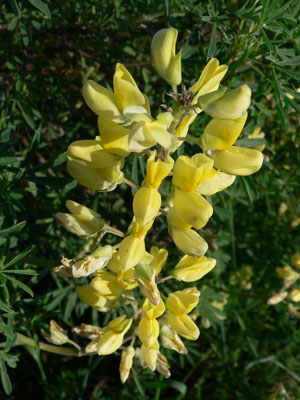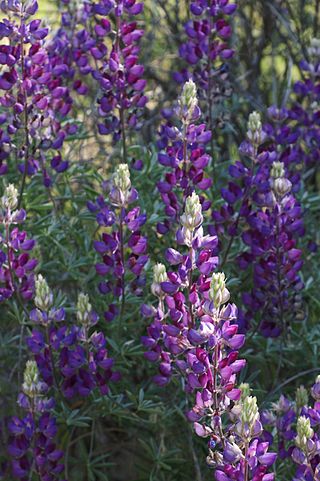
Lupinus polyphyllus, the large-leaved lupine, big-leaved lupine, many-leaved lupine, blue-pod lupine, or, primarily in cultivation, garden lupin, is a species of lupine (lupin) native to western North America from southern Alaska and British Columbia and western Wyoming, and south to Utah and California. It commonly grows along streams and creeks, preferring moist habitats.

Lupinus, commonly known as lupin, lupine, or regionally bluebonnet, is a genus of plants in the legume family Fabaceae. The genus includes over 199 species, with centers of diversity in North and South America. Smaller centers occur in North Africa and the Mediterranean. They are widely cultivated, both as a food source and as ornamental plants, but are invasive to some areas.

Lupinus arboreus, the yellow bush lupine (US) or tree lupin (UK), is a species of flowering plant in the legume family Fabaceae.

Lupinus microcarpus, the wide-bannered lupine or chick lupine, is a species of lupine native to western North America from southwestern British Columbia south through Oregon and California, including the Mojave Desert, and into Baja California. There is also a disjunct population in South America, with locations in central Chile and western Argentina.

Eriogonum fasciculatum is a species of wild buckwheat known by the common names California buckwheat and flat-topped buckwheat. Characterized by small, white and pink flower clusters that give off a cottony effect, this species grows variably from a patchy mat to a wide shrub, with the flowers turning a rusty color after blooming. This plant is of great benefit across its various habitats, providing an important food resource for a diversity of insect and mammal species. It also provides numerous ecosystem services for humans, including erosion control, post-fire mitigation, increases in crop yields when planted in hedgerows, and high habitat restoration value.

Lupinus nanus, the sky lupine, field lupine, dwarf lupin, ocean-blue lupine or Douglas' annual lupine, is a species of lupine native to the western United States. It is found natively in California, Nevada, and on Steens Mountain in eastern Oregon. It tends to grow on slopes and in open or disturbed areas below 1300 meters.

Astragalus lemmonii, the Lemmon's milkvetch, is a rare plant of eastern California. It is a member of the bean family, the Leguminosae, and specifically a member of the subfamily Papilionoideae. The genus Astragalus is a large genus within this family; members of this genus are known as milkvetches or locoweeds. Close relatives of this particular species include Astragalus peckii and Astragalus lentiformis.

Botrychium pumicola, with the common name pumice moonwort, is a rare fern.

Bromus hordeaceus, the soft brome, is an annual or biennial species of grass in the grass family (Poaceae). It is also known in North America as bull grass, soft cheat, and soft chess.

Lupinus bicolor is a species of lupine known as the miniature lupine, Lindley's annual lupine, pigmy-leaved lupine, or bicolor lupine.
Bearded lupine is a common name for several flowering plants and may refer to:

Lupinus excubitus is a species of lupine known as the grape soda lupine. Its common name refers to its sweet scent, which is said to be very reminiscent of grape soda. This species and its variants are found in Southwestern United States, especially in California and Nevada, e.g., Death Valley and Joshua Tree National Parks, and northwestern Mexico.

Lupinus albifrons, silver lupine, white-leaf bush lupine, or evergreen lupine, is a species of lupine (lupin). It is native to California and Oregon, where it grows along the coast and in dry and open meadows, prairies and forest clearings. It is a member of several plant communities, including coastal sage scrub, chaparral, northern coastal scrub, foothill woodland, and yellow pine forest.

Chrysothamnus viscidiflorus is an American species of shrub in the family Asteraceae known by the common names yellow rabbitbrush and green rabbitbrush.

Ribes lobbii is a shrubby, deciduous, shade-intolerant perennial dicot found on the western coast of North America. It was first described in 1876 by Asa Gray. The specific epithet was a dedication to the English plant collector William Lobb.

Lupinus croceus is a species of lupine known by the common names saffron-flowered lupine and Mt Eddy Lupine. It is endemic to the northernmost mountains of California, clustering in the Klamath Mountains, where it grows in generally dry, rocky habitat.

Lupinus latifolius is a species of lupine known by the common name broadleaf lupine. It is native to western North America from British Columbia to Baja California to New Mexico, where it is common and can be found in several types of habitat. There are several subtaxa, described as subspecies or varieties, some common and some rare. They vary in morphology. In general this plant is an erect perennial herb. It grows 30 centimeters to over two meters in height, in texture hairy to nearly hairless. Each palmate leaf is made up of several leaflets, those on larger plants up to 10 centimeters long. The inflorescence bears many flowers, sometimes in whorls. Each flower is one to two centimeters in length, purple to blue to white in color, the spot on its banner yellowish, pinkish, or white.

Lupinus saxosus is a species of lupine known by the common name rock lupine. It is native to eastern Washington, eastern Oregon, and the northeast corner of California,where it grows in sagebrush and other habitat. It may also be native to Idaho and Nevada.

Sabulina stolonifera is a rare species of flowering plant in the pink family known by the common names Scott Mountain sandwort and stolon sandwort.

Lupinus prunophilus, commonly known as the hairy bigleaf lupine or chokecherry lupin, is a medium-sized herbaceous plant that grows in the Great Basin and other parts of the U.S. interior between the Sierra-Nevada and the Rockies. It is a close relative and very similar to Lupinus polyphyllus and is considered a subspecies by some botanists.



















